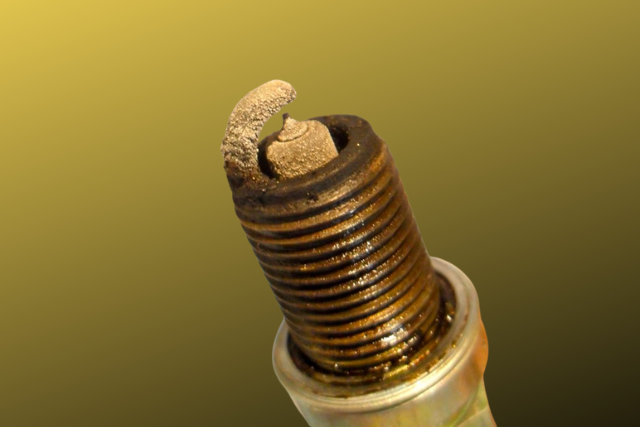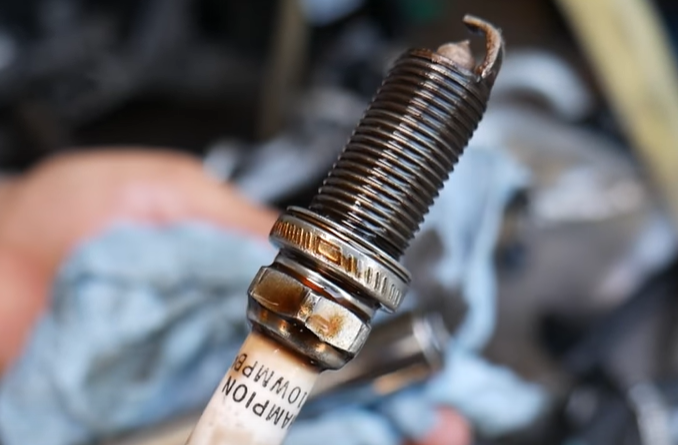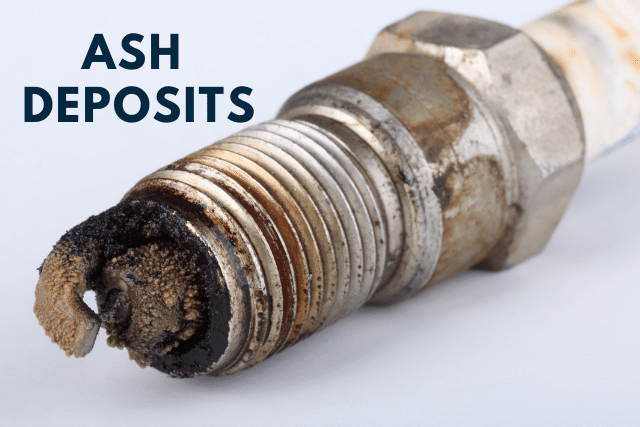Ash deposits are white sandy soot on spark plugs. They are concentrated on the electrodes and can over time affect spark plug performance.
So, why do spark plugs get ash deposits? The main reason for ash deposits on spark plugs is the oil getting sucked into the engine combustion chamber and burnt to form these white deposits.
While that’s the cause, let’s deep dive into how an ash deposit looks, how to identify them on spark plugs and what is the solution.
How ash deposits on a spark plug look

If the end of the spark plug has white deposits, is dry, and has a sandy texture – then the spark plug is covered in ash deposits.
The deposit might look very similar to that of carbon fouling.
But, the major difference here is the ash deposits are white in color. As opposed to carbon fouling, where the carbon buildup is black in color.
Another case is oil fouling. Here, the deposit much like carbon buildup is black in color, but these deposits are wet and slippery.
To make the distinction clear here is how you read the spark plug:
- Ash deposit: deposit on the spark plug is white, dry, and sandy in texture.
- Carbon buildup: deposit on the spark plug is black, dry, and covered in soot.
- Oil fouling: deposit on the spark plug is black but wet and slippery.
Another key thing to notice in ash deposits is that the deposits are primarily on the side (ground) electrode of the spark plug. This is another distinctive feature of ash deposits that can be used to identify them.
As you move away from the electrodes along the thread, the white sandy deposit fades down – indicating decreasing ash deposits.
What causes ash deposit on spark plugs?

The main reason for ash deposits on spark plugs is the oil getting sucked in atomized form and burnt to form these white deposits.
The engine oil in the crankcase is getting sucked into the combustion chamber.
But, the oil is entering the combustion chamber as tiny droplets, in atomized form. This is because the leakage is not through damaged or worn-out piston rings. Rather, the oil is leaked from damaged valve seals or valve guides.
This is important. The oil entering slowly and as tiny droplets as opposed to a high amount of oil entering at a time. This atomized oil is burnt on the spark plug.
And that’s how the burnt oil results in ash deposits on the spark plug.
How is this different from oil fouling?

After all, the oil enters the combustion chamber in oil fouling as well. Then, the same oil starts coating the spark plug leading to oil fouling.
So, how is it different from oil fouling? In oil fouling the amount of oil entering the engine is high. Not all oil is burnt and most are coating the spark plug thread.
Ash deposits, on the other hand, is burnt oil. The oil amount is not too much but enters the engine as tiny droplets. Most likely from damaged valve seals or valve guides. Not from damaged piston rings.
And that’s how these different deposits form.
Oil coating the spark plug results in oil fouling in the form of black wet deposits. Oil burnt on the spark plug results in ash deposits in the form of white dry deposits.
How do you get rid of ash deposits on spark plugs?

Now, we know the main culprit is oil leaking slowly into the engine combustion chamber.
This oil leakage in the form of tiny droplets is responsible for the ash deposits on spark plugs.
But, how do you get rid of it?
There are two parts here. One is how to get rid of already built-up ash deposits on the spark plugs. Two, how to ensure this deposit won’t repeat. Let’s call this the immediate solution and the preventive measures.
Immediate Solution
The immediate and short-term solution is to remove the spark plug and examine the level of ash deposits and act accordingly.
If the ash deposits are not too thick and not too much at the tip, you can clean the electrodes and fit the spark plug back. But, a better solution is to replace the spark plug altogether.
And of course, if the deposits are too much already, you must replace the spark plug with a new one. No point using that dirty white ashed spark plug there.
But the problem does not end here.
We are not addressing the root cause of the ash deposits. Even if you replace the spark plug with the new one, again, the new spark plug will have deposits in no time. Unless we address the core problem which is discussed below.
Preventive Measures
The main issue is the oil leaking into the combustion chamber. This needs to be addressed.
First and foremost, use high-quality engine oil. Don’t cheap out on this. Poor quality engine oil is not just bad for spark plugs but for the entire engine as well. In no time will the engine start overheating and start to perform poorly.
Second, examine the condition of the spark plug periodically. The best frequency is every time you take your motorcycle for servicing. Ensure that the spark plug condition is inspected at least once every six months.
Third and most important, check the condition of the valves regularly. Again, this inspection can be done whenever you take your motorcycle for servicing. Ensure the valves and their o-rings are in the best condition to function.
With the above three addressed, you should be able to avoid ash deposit formation on the spark plugs.
And to beat the dead horse, prevention is indeed better than cure!
To Summarize
- Ash deposits on spark plugs are white and dry deposits with a sandy texture.
- The main reason for ash deposits on spark plugs is the oil getting sucked in atomized form and burnt to form these white deposits.
- In oil fouling the amount of oil entering the engine is high. Not all oil is burnt and most are coating the spark plug thread.
- Ash deposits, on the other hand, is burnt oil. The oil amount is not too much but enters the engine as tiny droplets. And that’s how these different deposits form.
- The immediate and short-term solution is to remove the spark plug and examine the level of ash deposits and act accordingly.
- If the deposits are too much, you must replace the spark plug with a new one.
- To prevent ash deposit formation on spark plugs, use high-quality engine oil, inspect spark plugs at regular intervals, and periodically check the condition of the valves.
